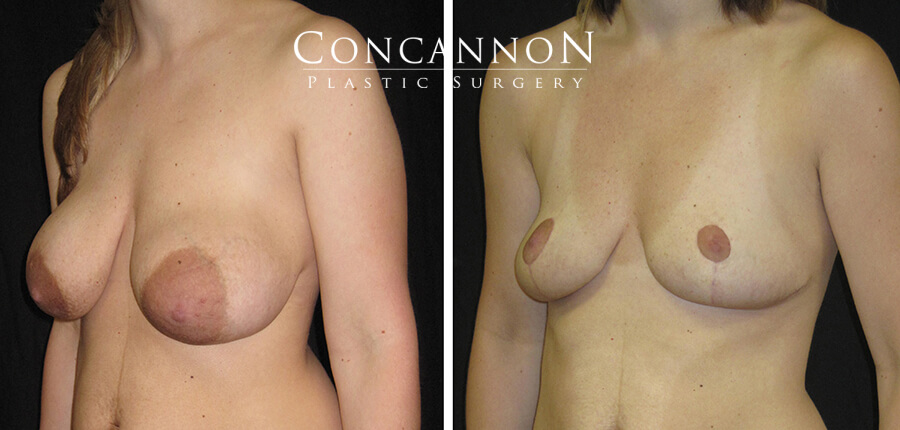Breast Lift
If You Are Considering A Breast Lift
Over the years, factors such as pregnancy, nursing, and the force of gravity take their toll on a woman’s breasts. As the skin loses its elasticity, the breasts often lose their shape and firmness and begin to sag. Breast lift, or mastopexy, is a surgical procedure to raise and reshape sagging breasts.

General Information
Mastopexy can also reduce the size of the areola, the darker skin surrounding the nipple. If your breasts are small or have lost volume – for example, after pregnancy – breast implants inserted after mastopexy can increase both their firmness and their size. If you’re considering a breast lift, this will give you a basic understanding of the procedure – when it can help, how it’s performed, and what results you can expect. It can’t answer all of your questions, since a lot depends on your individual circumstances. Please be sure to ask Dr. Concannon if there is anything about the procedure you don’t understand.

The Best Candidates for Breast Lift
A breast lift can enhance your appearance and your self-confidence, but it won’t necessarily change your looks to match your ideal, or cause other people to treat you differently. Before you decide to have surgery, think carefully about your expectations and discuss them with Dr. Concannon.
The best candidates for mastopexy are healthy, emotionally-stable women who are realistic about what the surgery can accomplish. The best results are usually achieved in women with small, sagging breasts. Breasts of any size can be lifted, but the results may not last as long in heavy breasts.
Many women seek mastopexy because pregnancy and nursing have left them with stretched skin and less volume in their breasts. However, if you’re planning to have more children, it may be a good idea to postpone your breast lift. While there are no special risks that affect future pregnancies (for example, mastopexy usually doesn’t interfere with breast-feeding), pregnancy is likely to stretch your breasts again and offset the results of the procedure.
All Surgery Carries Some Uncertainty and Risk
A breast lift is not a simple operation, but it’s normally safe when performed by a qualified plastic surgeon. Nevertheless, as with any surgery, there is always a possibility of complications or a reaction to the anesthesia. Bleeding and infection following a breast lift are uncommon, but they can cause scars to widen. You can reduce your risks by closely following Dr. Concannon’s advice both before and after surgery.
Mastopexy does leave noticeable, permanent scars, although they’ll be covered by your bra or bathing suit. (Poor healing and wider scars are more common in smokers–for that reason Dr. Concannon will not typically perform this surgery in an active smoker).
Planning Your Surgery
In your initial consultation, it’s important to discuss your expectations with your Dr. Concannon, and to obtain his opinion. Every patient – and every physician, as well – has a different view of what is a desirable size and shape for breasts.
Dr. Concannon will examine your breasts and measure them while you’re sitting or standing. He will discuss the variables that may affect the procedure – such as your age, the size and shape of your breasts, and the condition of your skin. You should also discuss where the nipple and areola will be positioned; they’ll be moved higher during the procedure, and should be approximately even with the crease beneath your breast.
Dr. Concannon will describe the procedure in detail, explaining its risks and limitations and making sure you understand the scarring that will result. He will also explain the anesthesia to be used, the type of facility where the surgery will be performed, and the costs involved.
Don’t hesitate to ask Dr. Concannon any questions you may have, especially those regarding your expectations and concerns about the results.
Preparing for Your Surgery
Depending on your age and family history, you may need to have a mammogram (breast x-ray) before surgery. You’ll also get specific instructions on how to prepare for surgery, including guidelines on eating and drinking, smoking cessation, and taking or avoiding certain vitamins and medications.
While you’re making preparations, be sure to arrange for someone to drive you home after your surgery and to help you out for a few days if needed.
Where Your Surgery Will Be Performed
The surgery is usually performed in our fully accredited office surgical suite, using IV sedation and local anesthesia. This is where the vast majority of these are done.
If you desire a general anesthetic, the surgery can be done at the Institute for Outpatient Surgery. This option is usually chosen by those who are combining this with other procedures, such as a tummy tuck, which will require a general anesthetic.
Anesthesia
Breast lifts are usually performed by Dr. Concannon under IV sedation with local anesthesia. You are comfortable and drowsy during the operation.
Photo Gallery
Vew the results of previous patients on
Dr. Concannon’s extensive photo gallery
The Procedure
Mastopexy usually takes one to two hours. The most common procedure involves an anchor-shaped incision following the natural contour of the breast. The incision outlines the area from which breast skin will be removed and defines the new location for the nipple. When the excess skin has been removed, the nipple and areola are moved to the higher position. The skin surrounding the areola is then brought down and together to reshape the breast. The stitches that Dr. Concannon uses are placed beneath the skin (hidden) to minimize scarring; the incisions are located around the areola, in a vertical line extending downwards from the nipple area, and along the lower crease of the breast.
Some patients, especially those with relatively small breasts and minimal sagging, may be candidates for modified procedures requiring less extensive incisions. One such procedure is the “doughnut (or concentric) mastopexy,” in which circular incisions are made around the areola, and a doughnut-shaped area of skin is removed.
Aftercare
After surgery, you’ll wear a bulky gauze dressings. Your breasts will be bruised, swollen, and uncomfortable for a day or two, but the pain shouldn’t be severe. Any discomfort you do feel will be relieved with medication.
The day after surgery, the dressing will be replaced by a soft support bra. You’ll need to wear this bra around the clock for three weeks or so. The sutures are dissolvable, so none will need to be removed.
If your breast skin is very dry following surgery, you can apply a moisturizer several times a day. Be careful not to tug at your skin in the process, and keep the moisturizer away from the suture areas.
Getting Back to Normal
Healing is a gradual process. Although you may be up and about in a day or two, you may delay a return to work for a week or more, depending on how you feel. Avoid lifting anything over your head for three to four weeks. If you have any unusual symptoms, don’t hesitate to call Dr. Concannon or his staff.
Dr. Concannon will give you detailed instructions for resuming your normal activities. You will be instructed to avoid strenuous activity or sports for several weeks. After that, you can resume these activities slowly. If you become pregnant, the operation should not affect your ability to breast-feed, since your milk ducts and nipples will be left intact.
Your New Look
Dr. Concannon will make every effort to make your scars as inconspicuous as possible. Still, it’s important to remember that mastopexy scars are permanent. They often remain lumpy and red for months, then gradually become less obvious, sometimes eventually fading to thin white lines. Fortunately, the scars can usually be placed so that you can wear even low-cut tops.
Your satisfaction with a breast lift is likely to be greater if you understand the procedure thoroughly and if your expectations are realistic.

